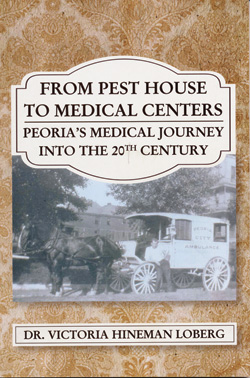The story of Peoria’s first hospital…
Many of us know the history of the three present-day Peoria hospitals and consider St. Francis Hospital to be the city’s first hospital, established in 1876. Yet few know the story of the hospital founded a quarter century earlier…
Elias Samuel Cooper was an Ohio native who apprenticed from 1838 to 1839 with a Dr. Waugh at an unknown location prior to establishing a large medical practice. In the early 1800s, educational requirements and medical licensure laws did not exist, and anyone could call themselves a doctor, regardless of training or lack thereof. At age 24, Cooper relocated to Peoria. In addition to teaching anatomy, he wrote papers and constantly practiced surgical techniques, sleeping only a few hours every night. He seemed driven to be the best, despite his young age.
Just one year after the use of chloroform as an anesthetic was reported in medical literature, Cooper performed a surgery with chloroform. According to some reports, he was the first doctor west of Pennsylvania to do so, and for this, the Peoria City Medical Society labeled him “reckless” and censored him. Its minutes noted: “The general feeling of the Society seemed to be adverse to the use of either ether or chloroform except in operations of an extremely painful and protracted nature.”
Because he required a constant supply of cadavers for teaching and to practice surgical techniques, rumors of grave robbing haunted Cooper. Grave robbers, also termed “resurrectionists” or “body snatchers,” sought to illegally meet the demand for cadavers. The graves of paupers, slaves or unknowns were prime targets, but no graves were safe, as the dearly departed could be protected only by an iron coffin, vault or an overnight armed guard. After two weeks, the grave was safe due to decomposition of the corpse. Grave robbing was most successful during the cooler months.
In 1851, Cooper established the Peoria Eye Infirmary and Orthopedic Institute, an interesting combination of surgical specialties. The American Orthopedic Association credits it as the second orthopedic hospital in the United States. Located about a mile from Peoria city limits at the time, and with space for 41 patients, the three-story building also housed Cooper’s anatomical museum and dissecting rooms. Local children called it the “spook house.” A Peoria newspaper reported: “Every evening the lady inmates assemble in the parlor and recite lessons in French, after which the Dr. or a friend reads aloud from a book. The patients almost forget they are under the care of a physician.”
However, the membership of the Peoria City Medical Society continued to view Cooper with contempt, as indicated in minutes from 1853: “The conduct of Dr. E. S. Cooper in advertising his… Infirmary and Orthopedic Institute in a very unprofessional manner has rendered himself obnoxious…”

Despite his travels to London and Paris to study surgical techniques, Peoria’s medical community did not appreciate Cooper’s skills. After 11 contentious years in the city, Cooper left for California, where he felt more surgical and teaching opportunities awaited him. Reaching San Francisco in May of 1855, he eventually became the most famous surgeon on the West Coast, and as he had done in Peoria, Cooper established an eye, ear and orthopedic clinic. Cooper’s friend, Dr. Daniel Brainard, founded Rush Medical College in Chicago when he was only 31 years old. Likely influenced by Brainard, 38-year-old Cooper founded the first medical school on the Pacific coast in 1858. The Medical Department of the University of the Pacific became the predecessor of Stanford Medical School. It is ironic that four years later, this gifted, largely self-taught surgeon developed an unknown neurological disorder and died blind. Consistent with his Quaker upbringing, Cooper was buried after a simple ceremony—with no gravestone.
More than half a century after his death, historians in the 1900s described Cooper as “the most active, progressive, original and enterprising member” of Peoria’s early medical community. Too late did Peoria recognize the surgical genius of Dr. Elias Samuel Cooper. iBi
A retired physician, Dr. Loberg most recently taught anatomy and physiology at Illinois Central College. This story is condensed from her book, From Pest House to Medical Centers: Peoria’s Medical Journey Into the 20th Century, which chronicles the colorful characters that comprise Peoria’s rich medical history. It is available for purchase at I Know You Like A Book and Broms Furs & Fashions in Peoria Heights, the gift shop at Methodist Medical Center, or directly from the author.


